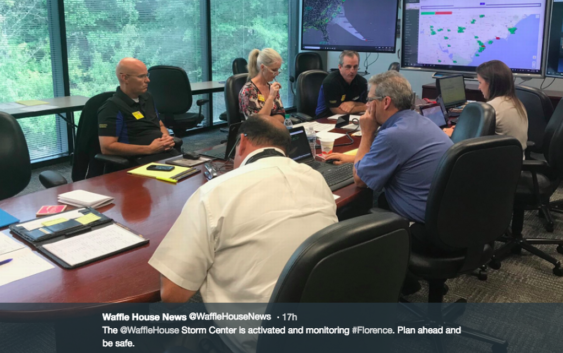- Seven months after Hurricane Helene, Chimney Rock rebuilds with resilience
- Wildfire in New Jersey Pine Barrens expected to grow before it’s contained, officials say
- Storm damage forces recovery efforts in Lancaster, Chester counties
- Evacuation orders lifted as fast-moving New Jersey wildfire burns
- Heartbreak for NC resident as wildfire reduces lifetime home to ashes
Hurricane Florence is almost here, but Waffle House is still cooking … mostly

This story was updated at 8 p.m. Eastern.
Hurricane Florence is starting to make its presence known in the Carolinas, but for now, Waffle House’s hash browns are mostly still sizzling and its eggs are still cracking. The restaurant chain, famous for staying open even through major disasters, seems to have kept the majority of its restaurants in operation as the storm approaches.
However, at least a few reported closings throughout the Carolinas suggest Waffle House could be acknowledging the seriousness of the incoming storm.
Fox8 reporter Lindsay Tuman tweeted that a Waffle House in Benson, North Carolina, about an hour and 30 minutes from Wilmington, was shutting down on Thursday.
Weather Channel editor Ryan Sloane tweeted that a Waffle House in Morehead City, North Carolina, shut down and “employees will be dispatched to other franchise locations.”
Weather Channel meteorologist Mike Seidel said the Wilmington Waffle House was operating at a “Code Yellow” which means it had a limited menu on Thursday.
On Wednesday, a Myrtle Beach location had shut down until Hurricane Florence has passed, as reported by local NBC affiliate WMBF.
WMBF posted a photo of the glass door of the Waffle House with a black and white sign taped up that read “We plan to open as soon as the storm passes” and included a number to call in case of emergencies.
On Twitter Wednesday, Waffle House wrote that it was closely watching the storm for any developments.
“The @WaffleHouse Storm Center is activated and monitoring #Florence,” the breakfast bistro wrote. “Plan ahead and be safe.” It included a photo of a group of people in the “storm center” gathered around a conference table. At the front of the room, three screens showed storm maps and news coverage of Category 4 hurricane’s path.
As of Thursday evening, Waffle House hadn’t tweeted since Wednesday.
The restaurants keep action plans for how to keep the restaurants working under storm conditions, and “jump teams” can travel to affected areas and help keep things moving, NPR reported.
With several major cities in the storm’s path, Waffle House is likely only one of many companies watching and waiting to see how they may need to react if things turn bad.
But Waffle House is different — so different, in fact, that the Federal Emergency Management Agency actually pays close attention to which restaurants the company decides to close during a hurricane or other disaster.
Informally, it’s called the “Waffle House Index,” and it’s a real thing.
Former FEMA administrator Craig Fugate came up with the idea while leading Florida’s emergency management agency, FEMA wrote.
“They are open most of the time. And that was the index. If a Waffle House is closed because there’s a disaster, it’s bad. We call it red. If they’re open but have a limited menu, that’s yellow,” he said. “If they’re green, we’re good, keep going. You haven’t found the bad stuff yet,” Fugate said on NPR.
The idea isn’t to look just at Waffle House, but to use it as a proxy to determine how badly the disaster has affected the area, and to learn how quickly it is recovering, FEMA wrote in a blog post.
“…The Waffle House test doesn’t just tell us how quickly a business might rebound – it also tells us how the larger community is faring. The sooner restaurants, grocery and corner stores, or banks can re-open, the sooner local economies will start generating revenue again – signaling a stronger recovery for that community. The success of the private sector in preparing for and weathering disasters is essential to a community’s ability to recover in the long run.”